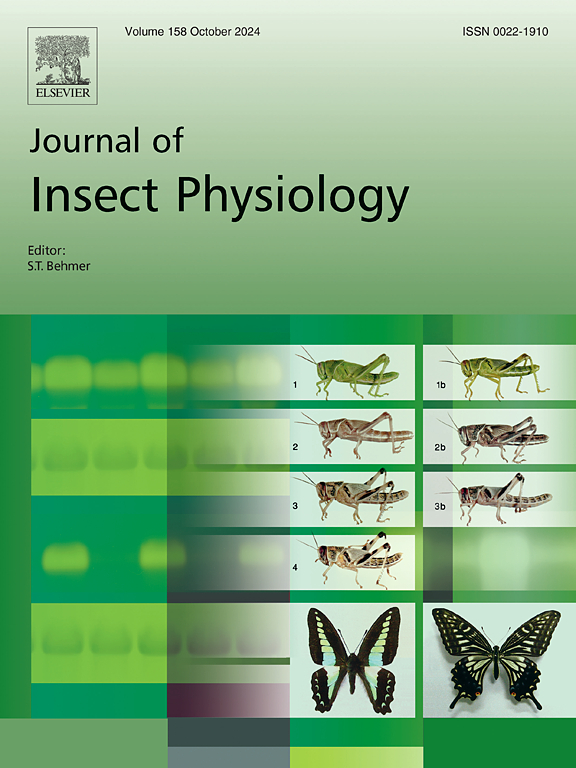拮抗肌协同激活的时机影响螳螂攻击时的前腿运动。
IF 2.3
2区 农林科学
Q1 ENTOMOLOGY
引用次数: 0
摘要
螳螂撞击时的前腿运动可以通过三个关节角度来确定:胸前-髋(P-C)、髋-粗隆(C-T)和股骨-胫骨(F-T)。为了了解中国螳螂的前腿运动是如何受肌肉活动控制的,我们将运动分析与肌电图(EMG)记录结合起来,分别来自三对拮抗剂:P-C关节的髋部启动器和远端肌,C-T关节的粗股骨伸肌和屈肌,F-T关节的胫骨伸肌和屈肌。在P-C关节角度增加的过程中,在臀部启动子的肌电图记录中观察到一阵尖峰。启动子的爆发伴随着臀部远端突刺的爆发。在C-T关节也观察到拮抗肌,伸肌和屈肌的共同激活,但在F-T关节没有观察到。启动或伸肌的爆发持续时间主要决定了P-C、C-T和F-T关节的峰值角。在P-C和C-T关节角增加过程中观察到拮抗剂的共激活可能对调节关节角峰值起作用;关节峰值角度随着远端肌(或屈肌)爆发时间的提前而减小。拮抗剂爆发时间的变化可以很好地调节关节峰值角度。本文章由计算机程序翻译,如有差异,请以英文原文为准。

Timing of the co-activation of antagonist muscles affects foreleg movements during mantis strikes
The foreleg movements during mantis strikes can be determined by three joint angles: the prothorax–coxa (P–C), coxa–trochanter (C–T), and femur–tibia (F–T). To understand how foreleg movements are controlled by muscle activities in the Chinese mantis, we combined motion analysis with electromyogram (EMG) recordings from three antagonist pairs, one at a time: the coxal promotor and remotor in the P–C joint, the trochanteral extensor and flexor in the C–T joint, and the tibial extensor and flexor in the F–T joint. During the P–C joint angle increase, a burst of spikes was observed in the EMG recordings from the coxal promotor. The promotor burst was accompanied by a burst of spikes in the coxal remotor. Co-activation of antagonist muscles, the extensor and flexor, was also observed at the C–T joint, but not at the F–T joint. The burst duration of the promotor or extensor mainly determined the peak angle of the P–C, C–T, and F–T joints. Co-activation of antagonists observed during P–C and C–T joint angle increases likely plays a role in adjusting the peak joint angle; the peak joint angle became smaller as remotor (or flexor) bursts occurred earlier. Variation in the timing of antagonist bursts may finely regulate the peak joint angle.
求助全文
通过发布文献求助,成功后即可免费获取论文全文。
去求助
来源期刊

Journal of insect physiology
生物-昆虫学
CiteScore
4.50
自引率
4.50%
发文量
77
审稿时长
57 days
期刊介绍:
All aspects of insect physiology are published in this journal which will also accept papers on the physiology of other arthropods, if the referees consider the work to be of general interest. The coverage includes endocrinology (in relation to moulting, reproduction and metabolism), pheromones, neurobiology (cellular, integrative and developmental), physiological pharmacology, nutrition (food selection, digestion and absorption), homeostasis, excretion, reproduction and behaviour. Papers covering functional genomics and molecular approaches to physiological problems will also be included. Communications on structure and applied entomology can be published if the subject matter has an explicit bearing on the physiology of arthropods. Review articles and novel method papers are also welcomed.
 求助内容:
求助内容: 应助结果提醒方式:
应助结果提醒方式:


